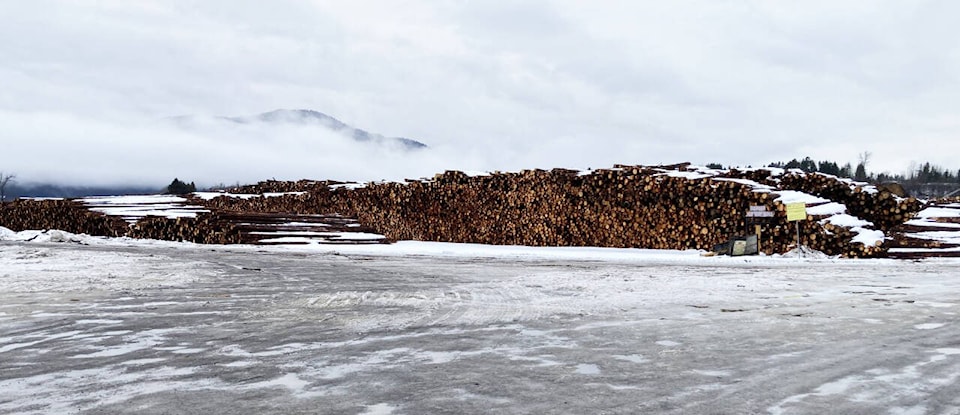A once dormant log yard has come back to life at the far western end of Keith Ave. in the light industrial sector of the city. For the past months it’s been the collection point for companies selling small-diameter logs to interior processors.
That’s thanks to a new venture by a business arm of the Lax Kw’alaams Band that owns the Poirier yard.
Carl Sampson who is the chief operating officer for Lax Kw’allams Business Development, said the logs are destined for the Kalum Logistics site, owned by the Kitsumkalum First Nation’s economic development arm. From the Kalum Logistics location just across the Kalum River adjacent to Kitsumkalum, the logs will be sent east to various locations, he said.
“Kalum Logistics has approval from the [Kitsumkalum] chief and council for this operation and is excited about the expansion of services at their logistics park,” said Sampson of the First Nation’s rail and truck material transport hub.
“All of the logs are destined for sawmills who will be milling the logs into lumber. We assume the residuals will primarily be used to produce chips and pellets, as is standard practice in B.C.”
Sampson said the logs are coming from various logging operations in the area, including from licences held by Coast Tsimshian Resources, another business arm of the Lax K’walaams.
“The logs are primarily small diameter spruce, pine and fir, as opposed to larger diameter hemlock and amabilis balsam that is typically milled at the local sawmill,” said Sampson of Skeena Sawmills.
“There is also some small diameter hemlock being delivered, a sort that is not desired by the local mill due to its size.”
Kim Haworth, the general manager of the City of Terrace-owned community forest, one of the companies sending logs to the yard, is excited about the opportunities now opening up.
He’s spent years hoping Skeena Sawmills would install a small-log sawing capability to handle the kind of logs cut by the community forest.
“We’re logging second generation growth from a second generation forest,” Haworth said in comparison to larger logs from much older sites.
Demand for wood from interior processors who can cut small diameter logs will help clear out weevil-damaged smaller-size spruce trees.
“The history of this goes back to the 1970s when after logging, spruce was planted. But that monculture of spruce became perfect feeding for the weevil,” Haworth said.
The community forest’s spruce is going to the Dunkley Forest Products sawmill and an adjacent pellet plant at Dunkley, south of Prince George.
The local mill it will help supply domestic wood to domestic processors.
“We’ve relied on export, and so have others up here, to keep viable but having a domestic market instead of exporting means there are local jobs,” he said.
The community forest is also sending a test shipment of hemlock, another species not wanted locally, to Nechako Lumber Company just outside of Vanderhoof, which has a sawmill and a pellet plant.
“If all this goes well, I can really see the interior market opening up for us,” Haworth said.
“The higher the utilization we can get, the better.”
Another kind of tenant has also been occupying portion of the yard.
“The arrival of the industrial style modular units are from a camp that has been demobilized in the Kitimat area, it is temporarily being stored until the owners determine their next destination,” said Sampson.
Coast Tsimshian Resources bought the yard as part of a deal to take over forest licences once held by regional forest giant Repap until it went out of business in the early 2000s.
